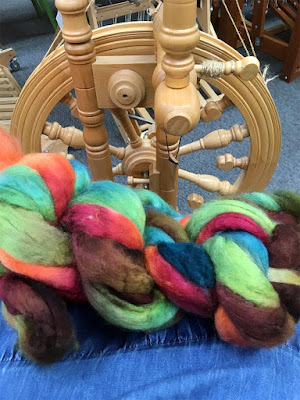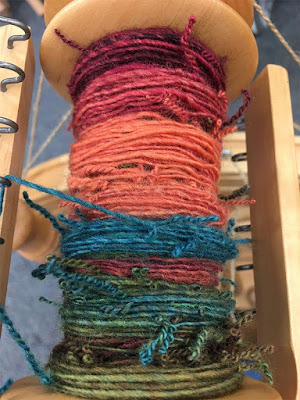Something something idle hands do the devil's work.
 |
| I really do adore this stuff. |
Well, I haven't been idle, but getting from fluff to the really quite lovely yarn I ended up with took some doing.
 |
| So much potential. |
This may be the first time I've ever brought my wheel to spin night, despite attending off and on for several years. My wheel is
beautiful. It was the first thing I bought just for fun after I got a big-kid job. It's stuffed with lovely details, and someday I'd love to paint it.
We have never gotten along.
I don't quite know why, but a lot of the problem is that I'm a talented spindler and prefer making high-twist, fine yarns—and there are a lot of things to adjust on a wheel, and a lot of ways it can help you make Not What I Intended yarn, and it's very frustrating to go into a project with an idea in mind, and come out of it with Not That.
This time, though, I have eight ounces of BFL and a plan, and it's a plan that should let me work through some of our issues with minimal screaming. I want light worsted weight 2-ply, and I'm not fussing about matching colors.
 |
| Not bad for a speedy guess and check. |
Step one, make a sample about the weight and twist quality I want. Suspiciously successful. That bit got snapped free and tied to a little wooden bobbin blank that hangs below the mother-of-all, so I can check my spinning against it as I go and stay consistent.
 |
| Better than last time I tried this. |
The first few layers of spinning went well! I had some pigtailing from overtwisting before the single would wind onto the bobbin, but nothing really awful. The layers did seem a bit loose compared with other spinners' bobbins I've seen, but there's probably a learning curve, right?
 |
| Pig! Tail! City! |
Um.
This is getting worse with experience, not better. What gives, little wheel?
Also, I spent quite a bit of the time I took to spin this much manually winding on, instead of having the wheel take up as it's meant to.
 |
| #glowup |
It turned out, after a lot of frustration and grumpily retying my drive band, that it was falling apart. Just...gently drifting into loosely associated wisps, rather than a cohesive loop. That explains many things, not least how I was able to crank it to the tightest possible setting and still struggle with takeup pace.
I replaced the worn-out drive band, and immediately had much smoother spinning on my hands, with only a few bobbles where I stopped paying attention for a moment and let pigtails get past me.
 |
| Such a satisfying thing to create. |
Because I only own three bobbins, and I want to try plying on my wheel as well as spinning, I wound my singles off the first two, and took advantage of the chance to smooth out all the pigtails, too. This is where I ran out of the first bobbin's singles—fairly consistent, despite all the wheel shenanigans on the way.
 |
| The bobbin is about the length of my hand. |
And this is where I ran out on the final bobbin—one partial layer of singles left, and perfectly arranged to pick up the final color of the third bobbin when I joined the beginning end of this bobbin to the tail. I wound the remainder into a center-pull ball without breaking the strand linking it to the plying ball, spit-felted the tail of the third bobbin to the beginning of the final bobbin, and continued winding until I had all my singles incorporated into the plying ball.
 |
| Glorious. |
Plying went shockingly smoothly, and I ended with about 450 yards of lovely, squooshy, drapey worsted weight. Now to decide what I'll make from it.









Comments
Post a Comment